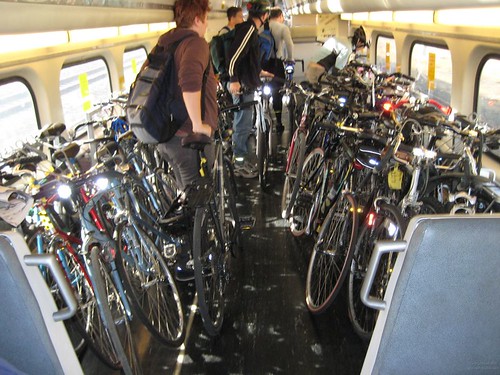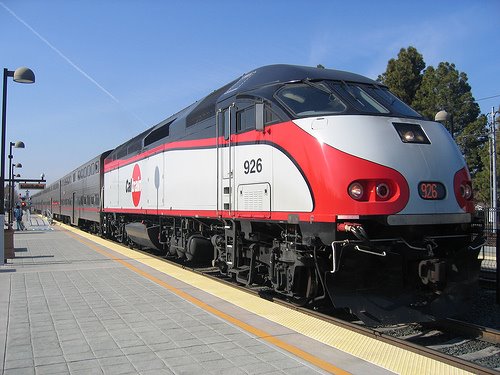More bikes on board
First, an apology. Last blog post, which I subsequently deleted, I commented on a power metric which I didn't fully understand. I like playing with formulas, I don't deny it. It's sort of my job (in semiconductor devices, not in cycling). I love trying to model stuff. But if I'm suggesting limitations in someone else's model, I'd better be really sure I understand what they're modeling! I'll still post my models here at some point, but in a more constructive fashion.
Today I attended the CalTrain meeting on increasing bike capacity on trains. It's fantastic Caltrain recognizes that given the profound limitations of public transit on the Peninsula, the bike + train combination is a uniquely attractive option. Indeed, it amazes me that anyone tolerates the solo-driver commute from the City. Living in San Francisco with a job on Palo Alto simply would not be an option for me if I were compelled to drive.

Caltrain bike car. You've gotta be nuts to days your carbon-fiber wünderbike here... but what choice is there for those Wednesday Noon Rides? :)
Caltrain proposed removing seats from the bottom level of all bike cars to expand bike car capacity, from 16 to 32 bikes on the newer Bombardier cars (leaving 3 seats), and from 32 to 40 on the older Gallery cars (removing all seats). San Francisco Bike Coalition's response what that this represented on the Bombardier cars, which lack line of sight between levels, a "stand or steal" choice with only the passengers able to watch over the security of 32 bikes. Theft, or other mishandling of bikes parked at the racks, is an obvious concern. Instead, SFBC wanted 80 bikes per train, with two bike cars per train, placing addition racks on the Bombardier cars at their mezzanine level. Caltrain rejected mezzanine-level racks as an bottleneck for pedestrian access between the two levels. SFBC in return advocated a one month delay in the decision, to allow a cooperation between the two in discusssing the tradeoffs of various options.
I proposed security cameras with monitors on the second level to allow those sitting upstairs to monitor their bikes below, but was told this was a "high six-figure" proposition which would require funding "possibly from the department of homeland security". Funny. I'm not worried about "the homeland", just my bike.
Silicon Valley Bike Coalition, which has a history perhaps of being less assertive than its San Francisco counterpart, proposed a more limited expansion on the Bombardier cars, from 16 to 24 instead of 16 to 32. This would allow the retention of more seats on the lower level, which would provide more options for those with a strong preference for sitting withing sight of their bikes, and in any case would provide more eyes to identify suspicious activity.
 Caltrain expressed reluctance for the additional delay in action proposed by SFBC, preferring to move ahead immediately with the SVBC proposal of a 16 to 24 bike capacity increase on the Bombardier cars. This would be applied to all existing bike cars, which would result in some sets with 48 bike capacity. On the Gallery sets, there was unanimous agreement that the original Caltrain plan of increasing capacity from 32 to 40 bikes was a worthy idea, and that was approved.
Caltrain expressed reluctance for the additional delay in action proposed by SFBC, preferring to move ahead immediately with the SVBC proposal of a 16 to 24 bike capacity increase on the Bombardier cars. This would be applied to all existing bike cars, which would result in some sets with 48 bike capacity. On the Gallery sets, there was unanimous agreement that the original Caltrain plan of increasing capacity from 32 to 40 bikes was a worthy idea, and that was approved.
I further recommended that the allowed per-rack capacity be increased from 4 to 4.5. While 5 bikes per rack sometimes creates a constriction in the isle, 4 on one rack with 5 on the opposing rack does not. This recommendation was not responded to. In any case, it requires only a change in policy, not in infrastructure, so could be implemented instantly. I also recommended space around the racks be used for bicycles. For example, bikes can be propped behind the racks, if the first bike on the rack is mounted with handlebars in the proper direction. Again, no response to this suggestion (which I am less optimistic will be accepted).
Overall, though, I have to be happy with the result: a substantial increase in bike capacity on the trains, directly addressing the Bombardier bottleneck. Caltrain needs to focus not only on total capacity, but on reliable capacity, and if there's the substantial chance of a 16-bike-capacity Bombardier set showing up at the stop, you simply can't have confidence you're going to get to your destination on time.
The cost: $200k, or $600 per seat removed, or around $3600 to $4800 per rack. A chunk of change for some really simple hardware. Still, a worthwhile investment to support Caltrain's most loyal customer base, one which has the least impact on other capacity constraints such as parking and station access. Thanks again to Caltrain for moving ahead with this.
Today I attended the CalTrain meeting on increasing bike capacity on trains. It's fantastic Caltrain recognizes that given the profound limitations of public transit on the Peninsula, the bike + train combination is a uniquely attractive option. Indeed, it amazes me that anyone tolerates the solo-driver commute from the City. Living in San Francisco with a job on Palo Alto simply would not be an option for me if I were compelled to drive.

Caltrain proposed removing seats from the bottom level of all bike cars to expand bike car capacity, from 16 to 32 bikes on the newer Bombardier cars (leaving 3 seats), and from 32 to 40 on the older Gallery cars (removing all seats). San Francisco Bike Coalition's response what that this represented on the Bombardier cars, which lack line of sight between levels, a "stand or steal" choice with only the passengers able to watch over the security of 32 bikes. Theft, or other mishandling of bikes parked at the racks, is an obvious concern. Instead, SFBC wanted 80 bikes per train, with two bike cars per train, placing addition racks on the Bombardier cars at their mezzanine level. Caltrain rejected mezzanine-level racks as an bottleneck for pedestrian access between the two levels. SFBC in return advocated a one month delay in the decision, to allow a cooperation between the two in discusssing the tradeoffs of various options.
I proposed security cameras with monitors on the second level to allow those sitting upstairs to monitor their bikes below, but was told this was a "high six-figure" proposition which would require funding "possibly from the department of homeland security". Funny. I'm not worried about "the homeland", just my bike.
Silicon Valley Bike Coalition, which has a history perhaps of being less assertive than its San Francisco counterpart, proposed a more limited expansion on the Bombardier cars, from 16 to 24 instead of 16 to 32. This would allow the retention of more seats on the lower level, which would provide more options for those with a strong preference for sitting withing sight of their bikes, and in any case would provide more eyes to identify suspicious activity.
 Caltrain expressed reluctance for the additional delay in action proposed by SFBC, preferring to move ahead immediately with the SVBC proposal of a 16 to 24 bike capacity increase on the Bombardier cars. This would be applied to all existing bike cars, which would result in some sets with 48 bike capacity. On the Gallery sets, there was unanimous agreement that the original Caltrain plan of increasing capacity from 32 to 40 bikes was a worthy idea, and that was approved.
Caltrain expressed reluctance for the additional delay in action proposed by SFBC, preferring to move ahead immediately with the SVBC proposal of a 16 to 24 bike capacity increase on the Bombardier cars. This would be applied to all existing bike cars, which would result in some sets with 48 bike capacity. On the Gallery sets, there was unanimous agreement that the original Caltrain plan of increasing capacity from 32 to 40 bikes was a worthy idea, and that was approved.I further recommended that the allowed per-rack capacity be increased from 4 to 4.5. While 5 bikes per rack sometimes creates a constriction in the isle, 4 on one rack with 5 on the opposing rack does not. This recommendation was not responded to. In any case, it requires only a change in policy, not in infrastructure, so could be implemented instantly. I also recommended space around the racks be used for bicycles. For example, bikes can be propped behind the racks, if the first bike on the rack is mounted with handlebars in the proper direction. Again, no response to this suggestion (which I am less optimistic will be accepted).
Overall, though, I have to be happy with the result: a substantial increase in bike capacity on the trains, directly addressing the Bombardier bottleneck. Caltrain needs to focus not only on total capacity, but on reliable capacity, and if there's the substantial chance of a 16-bike-capacity Bombardier set showing up at the stop, you simply can't have confidence you're going to get to your destination on time.
The cost: $200k, or $600 per seat removed, or around $3600 to $4800 per rack. A chunk of change for some really simple hardware. Still, a worthwhile investment to support Caltrain's most loyal customer base, one which has the least impact on other capacity constraints such as parking and station access. Thanks again to Caltrain for moving ahead with this.

Comments